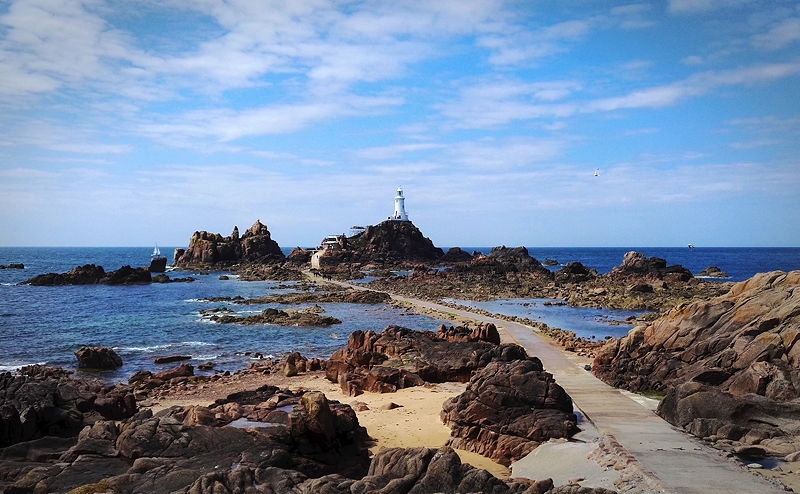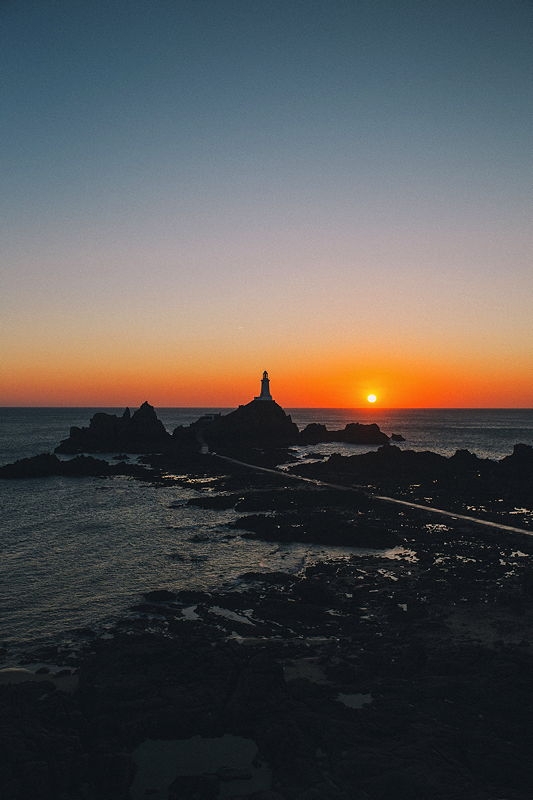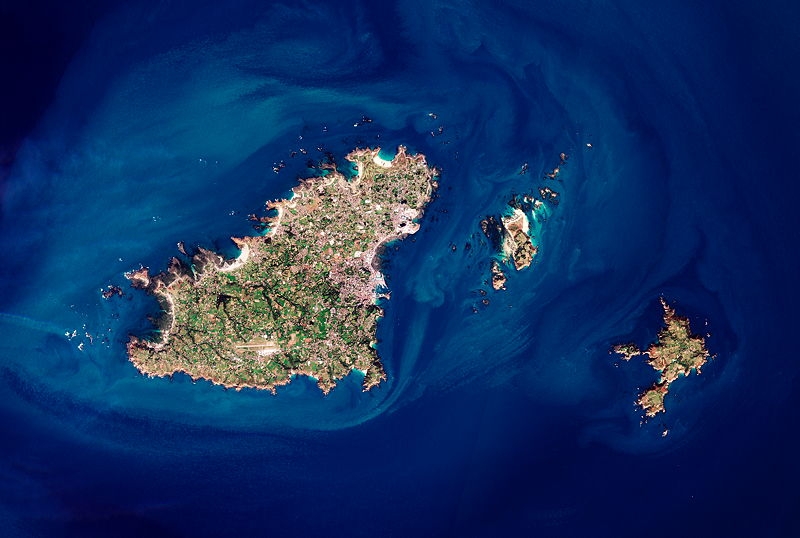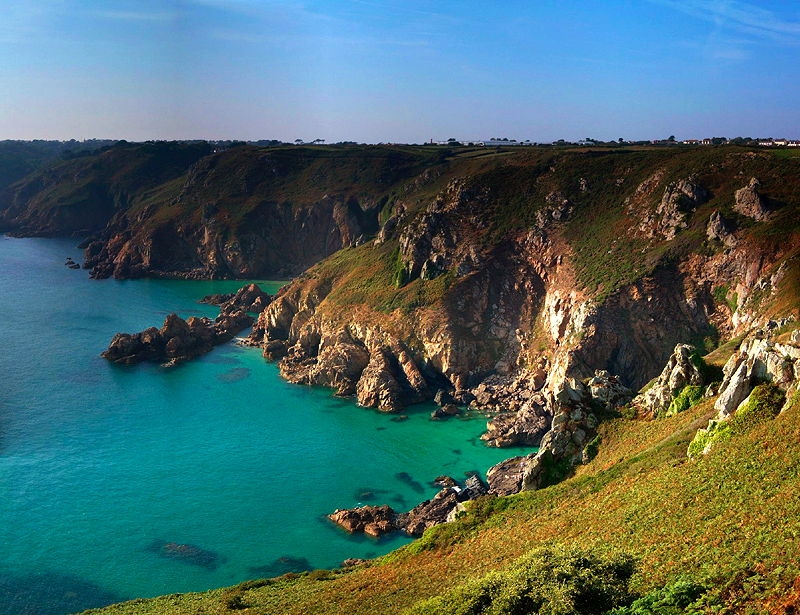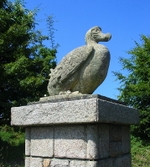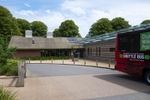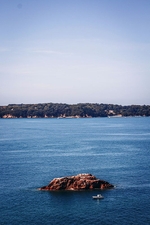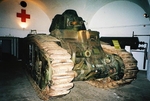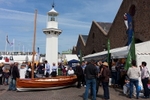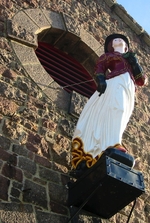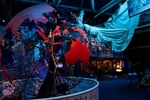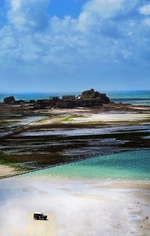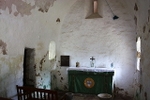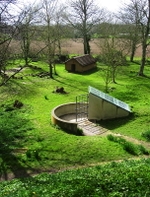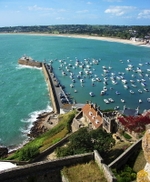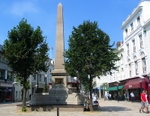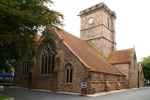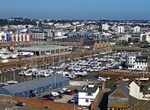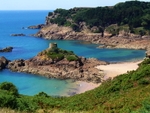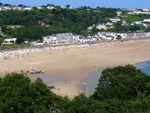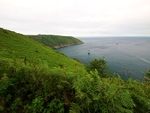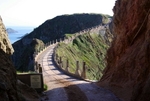1. The Durrell Wildlife Park (aka Jersey Zoo)
The Durrell Wildlife Park is a large zoo situated close to St Helier, and is Jersey's most popular attraction.
Established in 1959 by author and conservationist Gerald Durrell (1925 to 1995), the Park occupies 25 acres, holds over 190 different species of animal, and attracts about 150,000 visitors per year.
The Durrell Wildlife Park concentrates its efforts on rare and endangered species, such as its family of five western lowland gorillas (pictured), the Montserrat mountain chicken frog, and the Madagascan flat-tailed tortoise.
The Park's inhabitants are housed in distinct areas:
- the Jewel in the Forest aviary holds Asian birds such as the Mindanao Bleeding-heart Dove and the Hooded Pitta;
- the Cloud Forest is a mixed enclosure whose inhabitants include the Andean Bear, the Ring-tailed Coati and the Black Howler Monkey;
- the Gaherty Reptile and Amphibian Centre holds Burmese pythons, the Galapagos giant tortoise and the Strawberry poison-dart frog; and
- the Discovery Desert holds meerkats and desert mongoose.
The Park also offers a variety of tours and educational events, and contains an organic farm, children's play area and a number of eateries. A great family day out.
Where? The Park is four miles from St Helier, in the Trinity Parish, off the B31. Free parking for over 350 cars. Also on bus routes: 3a, 3b and 23.
When? Summer season (end of March to end of October): 9.30am to 6pm); Winter season (other times): 9.30am to 5pm. Closed 25 Dec.
£$€¥ Adults: £18; Seniors (65+): £16; Children (3-16): £14; Students (ID required): £16; Under-3s: free (May 2022).
2. Elizabeth Castle
Construction of Elizabeth Castle commenced in 1594, on account of Jersey's existing stronghold being unable to resist cannon attacks.
Building continued in the early 17th century under the supervision of Jersey's then governor, Sir Walter Raleigh. The castle soon became the Governor's official residence.
Since then, Elizabeth Castle has regularly seen military action: it was bombarded by Parliamentarian forces during the English civil war (1642-1651); held captured French prisoners during the Seven Years War (1755-1762); repelled a French invasion, led by Baron Phillipe de Rullecourt, during the 18th century Battle of Jersey; and was modernised and used by the Germans when the Channel Islands were occupied during the second world war.
The Castle can be accessed by causeway during low tide, and by ferry/watertaxi at other times. The Castle now offers great views out to sea, lots of rooms and grounds to explore, various exhibition rooms containing military memorabilia, together with guided tours and highly-rated historical re-enactments.
Where? Elizabeth Castle, St Aubin’s Bay, St Helier, JE3 3NU, or Castle Ferry Kiosk, Les Jardins de la Mer, West Park, St Helier, JE3 3NU. T: +44 (0)1534 723 971 (Castle) or +44 (0)1534 634048 (Castle Ferry Kiosk).
When? 10am to 5.30pm between early April and late October. Closed during the winter. See the website for more information.
£$€¥ Adults £13.20 (Castle and ferry £16.25); Seniors £11.90 (£14.95); Children/Students: £8.60 (£11.65). (May 2022)
3. The Jersey War Tunnels
Jersey was occupied by the Germans on 1 July 1940, after the British government had decided that they would not try to defend it, and was not liberated until 9 May 1945.
The German occupation was characterised by the introduction of numerous penal laws, severe food shortages, widespread fear and suspicion, and the forced labour used to buttress Hitler's Atlantic wall. Part of Hitler's defences comprised the Jersey War Tunnels.
The Jersey War Tunnels, which stretch to over 1 kilometre in length and are large enough to hold tanks, were designed to help German infantry resist air raids and artillery bombardment. They were built by slave workers and civilian prisoners controlled by the paramilitary Organisation Todt, excavating thousands of tonnes of rock and using it to make the man-made hill above the tunnels.
Later on in the war, the Jersey War Tunnels were equipped as an emergency hospital and casualty clearing station, complete with 500 beds, air conditioning and heating systems, and gas-proof doors.
The Tunnels have now been turned into substantial exhibition space, teaching visitors about the history of the Second World War, the occupation and the difficulties and dangers faced by locals.
Interesting fact ...
The War Tunnels' latest attractions are two escape rooms. Operation Constellation is up and running, with the second room due for completion soon. These rooms allow players to try to break into and out of the War Tunnels respectively. These 50 minute experiences cost £15 per person and are suitable for those aged 10+.Where? Jersey War Tunnels, Les Charrières Malorey, St Lawrence, Jersey, Channel Islands JE3 1FU. Bus route: 8A.
When? Open 10am to 5pm from late March until late October. Then 10am to 3pm until late November. Closed on 9 May (Liberation Day).
£$€¥ Adults: £16; Children (6-15): £10; Seniors: £15; Students: £15. (May 2022). Children under 6 go free.
4. Jersey Maritime Museum and Occupation Tapestry
The Jersey Maritime Museum teaches visitors about history and seafaring through a series of interactive displays. This makes it a great family activity.
Located in the historic St Helier harbour, the Maritime Museum's most popular activities include: a collection of items from HMS Havick, wrecked in a storm in St Aubin's bay in 1800; watching boat restorers at work; various model boats (including one of HMS Jersey); and interactive galleries that recreate the force of a gale and explain how to build ships.
The museum also houses the 72 foot long, 3 foot high Occupation Tapestry. Made by the people of Jersey over seven years, the Tapestry contains 12 panels each depicting a different event from Jersey's war history.
It comprises a remarkable 7.5 million stitches, and was presented to the public on the 50th anniversary of Jersey's liberation.
Where? New North Quay, St Helier, JE2 3ND.
When? 16 March to 30 October open daily 10am to 5pm; 31 October to 18 December open Sunday only 10am to 4pm. Closed 19 December to 3 January. For more information see the website..
£$€¥ Adults £11; Seniors (65+) £9.90; Children/Students £7.15. (May 2022).
5. Jersey's Beaches
Jersey has over 50 miles of coastline, including 12 major beaches and a host of other coves and bays.
The most popular beach is St Aubin's Bay, running for three miles on Jersey's south coast between St Helier and St Aubin. This beach is sandy (though the sand is permanently wet from La Haule to St Aubin), and has good parking, refreshment kiosks and beach cafes. The beach is very safe for swimming on account of its gentle gradient and calm waters.
Editor's choice ...
\*\*St Brelade's Bay\*\* beach is one of Jersey's most turquoise waters and sheltered in a pretty cove, popularity (particularly at weekends) is the only drawback. The beach is flanked by numerous cafes, bars and restaurants.St Ouen's Bay is a long sandy beach on the Island's west coast. It is far more exposed than the south coast beaches, and swimming can be treacherous. It is popular with surfers, windsurfers, sand yachters and walkers (who can also explore the numerous coastline bunkers and artillery positions which formerly formed part of Hitler's Atlantic Wall).
With its coarse golden sand and substantial shelter, the beach at Greve de Lecq is the most popular on the Island's north coast; the main drawbacks are its limited parking and abundance of sometimes aggressive seagulls.
The long sandy beach at Grouville, on the east coast, is another of the Island's favourites. Rarely overcrowded on account of its size, the beach is sheltered to all but easterly winds and has good parking and other facilities. Swimming is safe, though the sea retreats a substantial distance at low tide.
When? Jersey's climate is the mildest in the British Isles. Average sea temperatures between July and September are around 17 degrees Celsius.
£$€¥ Free
6. La Hougue Bie
Dating from the Neolithic period, or about 2500 BC, La Hougue Bie (meaning ‘mound of uncertain origin’) is one of the largest and best-preserved passage graves in Western Europe.
The site comprises an 18.6 metre passage chamber (or dolmen), the burial site of at least eight individuals, above which is found a 12.2 metre high earth mound crowned by two medieval chapels (dating from the 12th and 16th centuries respectively).
The burial chamber is aligned so as to allow sunlight to reach the back wall of its ‘terminal cell’ on the spring and autumn equinox.
Visitors are able to walk through La Hogue Bie's peaceful and spiritual complex; enjoy the geology and archaeology museum’s collections of coin hoards, axes, swords, spears and even a rhinoceros skull; and explore the adjacent command bunker built during the German occupation of the Island.
La Hougue Bie is featured on the 2010 issue Jersey £1 note. It is one of the ten oldest buildings in the world.
Where? La Hogue Bie, La Route de la Hougue Bie, Grouville, JE2 7UA.
When? Open daily from 16 March to 30 October - 10am to 5pm
£$€¥ Adults: £10.30; Seniors: £9.25; Children/Students: £6.70; Family Ticket (2 adults 2 children): £30.60 (May 2022)
7. Mont Orgueil Castle
Overlooking Gorey harbour, Mont Orgueil Castle (aka Gorey Castle, the Old Castle and Le Vier Chate) was constructed following the division of the Duchy of Normandy in 1204.
The Castle remained the first line of defence against French invasion until the construction of Elizabeth castle in 1594. Thereafter, it was converted into a prison, often holding political agitators such as William Prynne from the English mainland, and then for use as barracks. It was occupied by German forces during the second world war, and now appears on the Jersey £50 note.
Visitors will enjoy exploring the towers (with their stunning views making the 198 steps to the top worth the effort, and decommissioned cannons pointing towards France), turrets (where you will find the medieval ‘wheel of urine’!), dungeons (to explore the witchcraft exhibit) and gardens (where you can have your picture taken in stocks).
Mont Orgueil Castle also hosts ‘living history’ days, complete with jousting knights, and Chris Levine and Rob Munday’s exhibition ‘The Queen’ (featuring an impressive holographic portrait of Her Majesty). The Castle was featured in a Time Team episode in 2011 and has a licensed café and gift shop.
A great attraction for kids!
Where? Mont Orgueil Castle, Gorey, St Martin JE3 6ET.
When? 16 March to 30 October: Open daily 10am to 6pm; 31 October to 19 December: Every Friday, Saturday, Sunday, Monday - 10am to 4pm; Closed; 15 March, 20-26 December and 31 December. Please see the website
£$€¥ Adults: £13.95; Seniors: £12.55; Children/Students: £9.05; Family Ticket (2 adults 2 children) £41.40 (May 2022) please see the website
8. Jersey Museum and Art Gallery
Jersey has been inhabited for around 250,000 years.
Over that time, it has been fought over by the English and French and occupied by the Germans, developed its own language, democracy and legal system, and become an important tourist destination and offshore financial centre. The Island’s fascinating story is told at the Jersey Museum and Art Gallery.
Don’t miss the exhibits devoted to the 1781 Battle of Jersey, an unsuccessful invasion attempt by the French aimed at removing the threat the Island posed to American shipping during the American War of Independence.
Interesting fact ...
The Battle of Jersey led to fatalities of about 30 on each side, including local commander Major Peirson and French commander Baron Phillipe de Rullecourt, and to the capture of around 600 French soldiers.
Other highlights include a bronze age gold necklace, Sir John Everett Millais’ portrait of English concert hall singer, socialite and royal mistress Lillie Langtry (the daughter of the Dean of Jersey, who was born on the Island), numerous works by surrealists Claude Cahun and Marcel Moore (who lived and worked on the Island from the 1930s), a perfectly restored Victorian Merchant’s House (complete with traditional gas lamps and period furniture), galleries featuring Jersey landscapes, and exhibits devoted to the Island’s farming and tourism industries.
Where? The Weighbridge, St Helier JE2 3NG, Jersey.
When? 16 March to 30 October 10am to 5pm; 31 October to 23 December and 28-30 December 10am to 4pm; Closed 24 – 26, 31 December.
£$€¥ Adults: £11; Seniors: £9.90; Children/Students: £7.15; Family Ticket (2 adults 2 children) £32.65 (May 2022) please see the website
9. St Helier
Home to about 35,800, or roughly one-third of the population, St Helier is Jersey’s capital.
Named after a hermit, Helier, who lived on the nearby Hermitage Rock and died there at the hands of axe-wielding pirates in around 550AD, St Helier is also the commercial and shopping hub of the island.
St Helier is one of Jersey’s 12 parishes, so where better to start your visit than the St Helier Parish Church. Originally adjacent to the sea, the structure is now almost 1000 feet away (on account of land reclamation works). Though architecturally unimpressive (its steeple was flattened during the English Civil War), the future Kings Charles II and James II attended services here in 1646. The Church is used for important island events.
Next on your list should be the Royal Square, site of the Battle of Jersey in 1781. At the square’s centre is found a gilded statue of George II (1683-1760), erected in gratitude for a £300 royal subsidy for harbour works. Bordering the square are the Reform Club and the Royal Court and States Chamber (where visitors can see the island’s parliament in session some Tuesdays).
Don’t miss the lively Central Market, a steel and glass structure dating from 1882 which has at its centre an ornamental fountain and fishpond. The wares on sale include vibrant flowers, fruit and veg, meat, bread and cakes. The adjacent Beresford Market specialises in fish ranging from king prawns and conger eel to salted cod (a Jersey favourite).
You should also take time to visit the Main Post Office in Broad Street (Jersey stamps have become collectors items since they were introduced in 1969), King Street (Jersey’s main shopping promenade), and the Howard Davis Park (sponsored by a local philanthropist in memory of his son, a small cemetery for British and US serviceman who died in the second world war).
10. St Brelade's Bay
St Brelade's Bay, towards the south-west of the island, is Jersey's most famous seaside resort. Its pretty promenade is lined with cafes, restaurants and souvenir shops, looking onto its sheltered golden beach.
At the beach's western end is found the early Norman Fisherman's Chapel, one of a handful to survive the ransacking of 16th century 'reformers'. This small stone structure is simply decorated with restored murals depicting scenes from the Old and New Testaments (in particular The Assumption, dating from about 1310AD, The Resurrection and the Last Judgment).
The next-door St Brelade's Parish Church, one of Jersey's 12 ancient churches, probably contains some structures dating from about 1035 AD. Built of stone from the nearby beach, with limpet shells visible in the stonework, the church is also well known for its Henry Thomas Bosdet stained glass windows.
Another interesting fact is that the church has a path (or perquage) leading to the slipway; this was used to allow those who had claimed sanctuary in the church safe passage to the sea!
Continue to the west from the Parish Church along a beautiful winding path to the Beauport beach, a pristine sandy cove popular with locals.
Editor's choice
Slightly further inland is found the \[Jersey Lavender Farm](http://www.jerseylavender.co.uk/ "Jersey Lavender Farm website"), which grows, harvests and distils its own lavender to make oil. You can learn how lavender is distilled, buy oils, perfumes and soaps, or just roam around the lavender fields and take in the wonderful purple colour and fragrance.Those looking for a great food should consider the Oyster Box (for high class seafood), and the Old Smugglers Inn (a quaint tavern with wooden beams and roaring fires, offering real ales and traditional grub).
11. A day trip to Guernsey
At 24 square miles, Guernsey is half the size of Jersey.
But it accommodates 60,000, two-thirds of Jersey’s population, making it the most densely populated Channel Island. It is accessed by 15 minute flight, or hour-long ferry trip, from Jersey. And like its larger neighbour, Guernsey provides great history, stunning scenery, and fantastic food and accommodation.
Start your visit at St Peter Port, Guernsey’s capital and the prettiest of all the Channel Island ports. After you have finished taking in the yachts, fishing boats, ferries and catamaran, head to Castle Cornet, a well-preserved medieval fortress with great vantage points, museums and memorabilia from down the ages (ranging from a blunderbuss, to Victor Hugo’s personal lifejacket, to rifles used during the Falklands War).
Hautville House, Victor Hugo’s home during his 15 years of exile on Guernsey, is another must-see. Hugo initially sought refuge in Jersey, but was kicked out when he wrote an article criticising Queen Victoria! And don’t miss the Victoria Tower, built following Queen Victoria’s 1846 visit to Guernsey, and the La Valette Underground Military Museum, south of St Peter Port.
Interesting fact ...
Guernsey’s south coast is especially picturesque, with [Renoir](http://impressionistarts.com/pierre-auguste-renoir-biography.html) spending a month painting the cove at **Mouline Huet** in 1883. The best views are to be had at Jerbourg Point, on the island’s southeast corner, and **Pleimont Point**.Beaches are to be found on the north-western side of the island, with Rocquaine Bay and Grand Havre both well worth a visit. Finally, more of the island’s rich history is on offer at the highly rated German Occupation Museum in Forest.
12. Alderney, Sark and Herm
Alderney, Sark and Herm are the smaller of the Channel Islands on the tourist map.
Alderney has a size of 3 square miles and a population of 2,400, accessed by frequent 15-minute flights from Jersey. It is part of the Bailiwick of Guernsey, though it has its own legislature and court. Alderney’s main town, St Anne, is found in the middle of the island, and is a peaceful mix of pastel coloured houses bordering cobblestone streets. It has good shopping, a pretty church, and the Alderney Museum (full of interesting artefacts, including the contents of a recently discovered Elizabethan wreck).
The traditional Braye Harbour, home to a number of great bars and restaurants, is found in Alderney’s biggest bay. Other attractions include a number of sandy beaches (in particular Corblets Bay and Saye Bay), fortifications built by the Germans during the Second World War (after the entire population had been evacuated), the 16th century Essex Castle and the natural phenomenon of Hanging Rock.
Sark is just 2 square miles in size, and has a population of 600. It has no airport, and so is accessed by hour-long ferry ride from Jersey. Motorised transport is prohibited, save for tractors, and there are no tarmacked roads: so visitors are usually shown around by horse-drawn carriage. The best things to do are to visit the colourful Creux Harbour and La Seigneurie (home to the lord of the manor, with magnificent gardens open to the public in summer).
Herm is the smallest of the three, with a size of just half a square mile and a population of 50 people. It is visited by short ferry ride from Guernsey’s St Peter Port and is the ultimate destination for those seeking tranquility (even the playing of radios in public is outlawed!).
